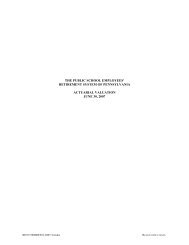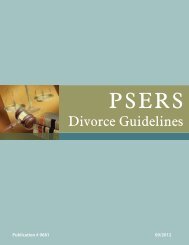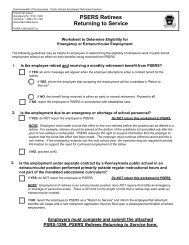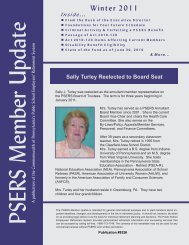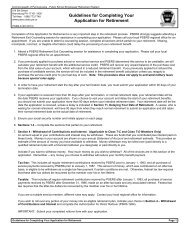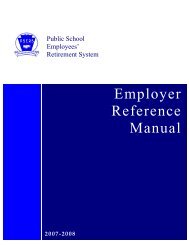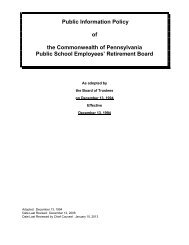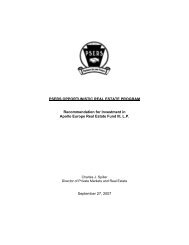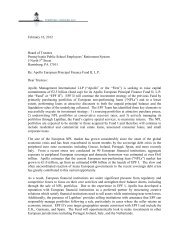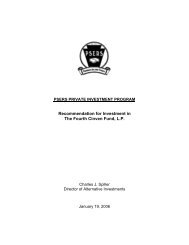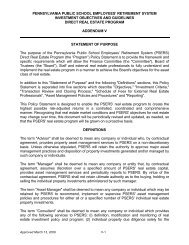a complete copy of the 2012 CAFR Report! - PSERs
a complete copy of the 2012 CAFR Report! - PSERs
a complete copy of the 2012 CAFR Report! - PSERs
You also want an ePaper? Increase the reach of your titles
YUMPU automatically turns print PDFs into web optimized ePapers that Google loves.
Notes to Financial Statements (continued)<br />
Swap agreements provide for periodic payments at<br />
predetermined future dates between parties based on <strong>the</strong><br />
change in value <strong>of</strong> underlying securities, indexes or interest<br />
rates. During <strong>the</strong> year ended June 30, <strong>2012</strong> and 2011, <strong>the</strong><br />
System entered into total return type swaps. Under <strong>the</strong> total<br />
return type swap arrangements, <strong>the</strong> System receives <strong>the</strong> net<br />
return <strong>of</strong> certain equity securities or indexes in exchange<br />
for a short-term rate minus a spread or a predetermined<br />
fixed charge. The receivable (payable) on <strong>the</strong> total return<br />
type swap contracts <strong>of</strong> $(23,260,000) and $28,794,000 at<br />
June 30, <strong>2012</strong> and 2011, respectively, is included in <strong>the</strong><br />
Statements <strong>of</strong> Plan Net Assets and represents <strong>the</strong> fair value<br />
<strong>of</strong> <strong>the</strong> contracts. The contracts have varying maturity dates<br />
ranging from August 14, <strong>2012</strong> to July 1, 2013.<br />
The System also invests in mortgage-backed securities<br />
(MBS) such as CMOs and MBS forwards to maximize<br />
yields. These securities are sensitive to prepayments <strong>of</strong><br />
mortgages, which may result from a drop in interest rates.<br />
The MBS forwards are subject to credit risk in <strong>the</strong> event<br />
<strong>of</strong> nonperformance by counterparties. The fair value <strong>of</strong><br />
CMOs at June 30, <strong>2012</strong> and 2011 is $1,437,519,000 and<br />
$1,735,359,000, respectively.<br />
The System invests in U.S. Treasury strips which<br />
essentially act as zero coupon bonds and are subject to<br />
market volatility from a rise or drop in interest rates.<br />
Through certain collective trust funds, <strong>the</strong> System also<br />
indirectly holds various derivative financial instruments.<br />
The collective trust funds invest in futures and options<br />
<strong>the</strong>reon; forward foreign currency contracts; options;<br />
interest rate, currency, equity, index, and total return<br />
swaps; interest-only strips; and CMOs, to enhance <strong>the</strong><br />
performance and reduce <strong>the</strong> volatility <strong>of</strong> <strong>the</strong>ir portfolios.<br />
6. Pension Plan for Employees <strong>of</strong> <strong>the</strong> System<br />
The System contributes to <strong>the</strong> Commonwealth’s State<br />
Employees’ Retirement System (SERS), a cost-sharing<br />
multiple-employer defined benefit pension plan. SERS<br />
provides retirement, death, and disability benefits to plan<br />
members and beneficiaries according to Commonwealth<br />
statute. SERS issues a publicly available financial report<br />
that can be obtained by writing to SERS, 30 N. Third Street,<br />
P. O. Box 1147, Harrisburg, Pennsylvania 17108-1147.<br />
The contribution requirements <strong>of</strong> plan members and <strong>the</strong><br />
System are mandated by Commonwealth statute. Most<br />
SERS plan members are required to contribute 5%, 6.25%,<br />
or 9.37% <strong>of</strong> <strong>the</strong>ir annual covered payroll depending upon<br />
service class. The System is required to contribute at an<br />
actuarially determined rate.<br />
FINANCIAL SECTION<br />
The rates applied to annual covered payroll were 6.99% at<br />
June 30, <strong>2012</strong>, 4.11% at June 30, 2011, 3.15% at June 30,<br />
2010. The System’s contributions to SERS for <strong>the</strong> years<br />
ended June 30, <strong>2012</strong>, 2011 and 2010 were $1,363,000,<br />
$790,000 and $601,000, respectively, which were equal to<br />
<strong>the</strong> required contributions each year.<br />
7. Postemployment Healthcare Plan for Employees<br />
<strong>of</strong> <strong>the</strong> System<br />
The System participates in <strong>the</strong> Commonwealth’s Retired<br />
Employees Health Program (REHP). The REHP is a<br />
single-employer plan and provides certain healthcare<br />
benefits to qualifying individuals meeting specified age<br />
and/or service requirements. The Commonwealth’s Office<br />
<strong>of</strong> Administration (OA), in its sole discretion, determines<br />
available REHP benefits on an ongoing basis. The<br />
Pennsylvania Employees Benefit Trust Fund (PEBTF) is a<br />
third-party administrator for <strong>the</strong> REHP under <strong>the</strong> provisions<br />
<strong>of</strong> an Administration Agreement between OA and PEBTF.<br />
Employer costs for retiree healthcare benefits are charged<br />
as a component <strong>of</strong> payroll expenditures on a ‘pay-as-yougo’<br />
basis. REHP funding is arranged between OA and<br />
<strong>the</strong> Governor’s Budget Office. FY <strong>2012</strong> employer costs<br />
were charged at <strong>the</strong> rate <strong>of</strong> $240/employee/bi-weekly pay<br />
period. Plan members who retired after June 30, 2005<br />
contribute to <strong>the</strong> plan based on a percentage <strong>of</strong> <strong>the</strong>ir final<br />
annual gross base salary at <strong>the</strong> time <strong>of</strong> retirement. Plan<br />
member contribution rates vary based on <strong>the</strong>ir REHP<br />
enrollment date.<br />
In September 2011, <strong>the</strong> Commonwealth released an<br />
Actuarial Valuation <strong>of</strong> its Post-Retirement Medical Plan<br />
with calculations made as <strong>of</strong> July 1, 2011 using census<br />
data collected as <strong>of</strong> December 2010 and health care claims<br />
costs for calendar 2010. This valuation provided O<strong>the</strong>r<br />
Postemployment Benefits (OPEB) reporting that was<br />
used for both FY 2011 and FY <strong>2012</strong>. For FY 2011, <strong>the</strong><br />
valuation indicated overall AOC <strong>of</strong> $883.2 million with<br />
<strong>the</strong> System’s allocated AOC $3.2 million. Based on <strong>the</strong><br />
aggregate REHP qualifying contributions for FY 2011, <strong>the</strong><br />
net OPEB liability for <strong>the</strong> System was $1.1 million for that<br />
fiscal year. For FY <strong>2012</strong>, <strong>the</strong> valuation indicated overall<br />
AOC <strong>of</strong> $870.2 million with <strong>the</strong> System’s allocated AOC<br />
$3.1 million. Based on <strong>the</strong> aggregate REHP qualifying<br />
contributions for FY <strong>2012</strong>, <strong>the</strong> net OPEB liability for <strong>the</strong><br />
System was $0.9 million for that fiscal year.<br />
PAGE 58




